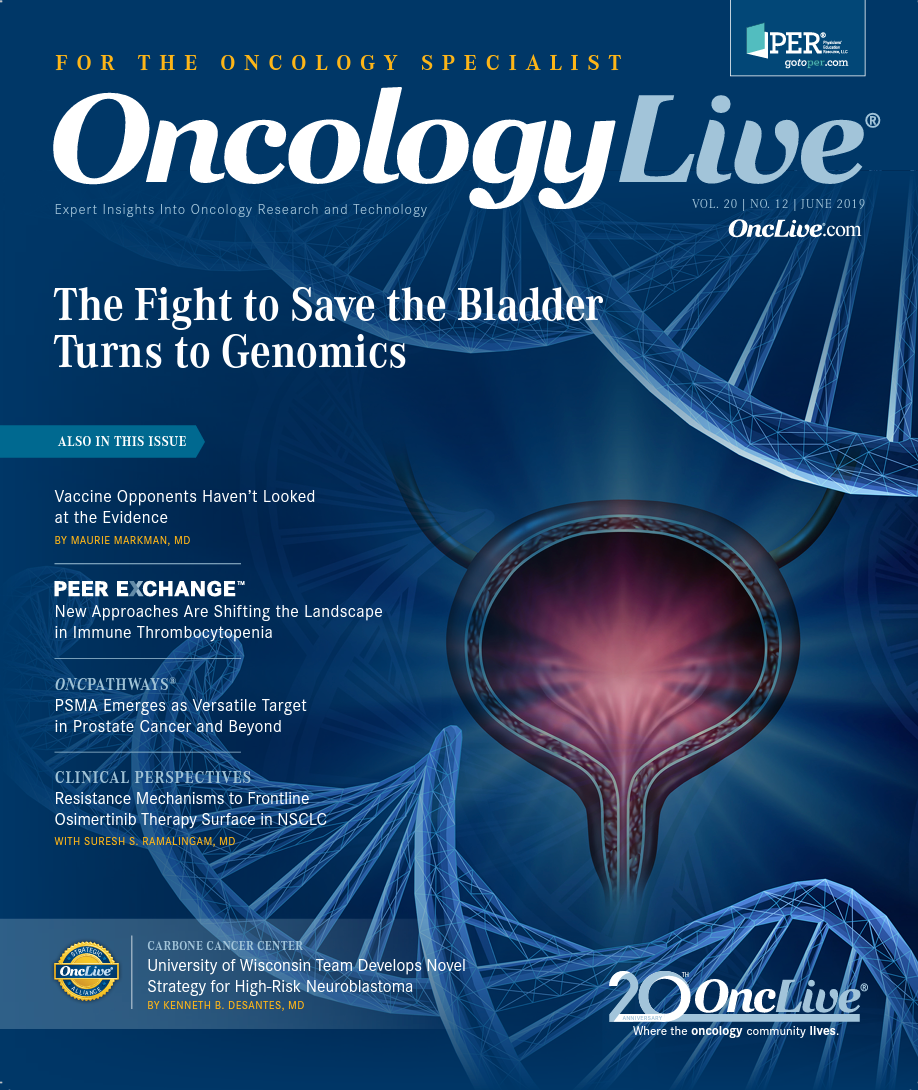Gilteritinib Helps Set New Pace in Acute Myeloid Leukemia
Alexander E. Perl, MD, discusses gilteritinib’s place in the acute myeloid leukemia landscape and its potential future in the frontline setting.
Alexander E Perl, MD

Alexander E Perl, MD
Gilteritinib (Xospata) has the potential to reshape the treatment paradigm for patients with FLT3-positive acute myeloid leukemia (AML), according to Alexander E. Perl, MD, a leading investigator into the drug.
The FDA approved gilteritinib, a small molecule that inhibits FLT3 and other kinases, as single-agent therapy for patients with relapsed/refractory AML harboring a FLT3 mutation based on remission rates in the phase III ADMIRAL trial (NCT02421939).
In an interview with OncologyLive®, Perl, associate professor in the Division of Hematology/Oncology at the Perelman School of Medicine and a member of the Abramson Cancer Center, both at the University of Pennsylvania in Philadelphia, discussed gilteritinib’s place in the AML landscape and its potential future in the frontline setting.
OncLive: Please comment on the rationale for the ADMIRAL trial.
Perl: ADMIRAL is a phase III registration study for gilteritinib in the population of patients with relapsed or refractory FLT3-mutated AML. FLT3 is a gene that encodes a tyrosine kinase that normally regulates hematopoiesis. Mutations in FLT3 occur in around a third of patients with AML and are associated with relapse and poor survival. Gilteritinib is a potent and selective oral FLT3 inhibitor and has shown activity in relapsed and refractory patients with FLT3-mutated AML.
The ADMIRAL trial enrolled patients with a FLT3 mutation who either had untreated first relapse or primary refractory disease after up to 2 attempts at achieving remission. Patients were randomized to either single agent gilteritinib or their physician’s choice of the best salvage regimen from options that included two standard intensive chemotherapy regimens—MEC [mitoxantrone, etoposide and intermediate-dose Ara-C] or FLAG-IDA [fludarabine, cytarabine, idarubicin, and granulocyte colony- stimulating factor]—or two low intensity regimens—azacitidine or low dose cytarabine.
There was no crossover to gilteritinib if patients did not respond to salvage chemotherapy. While the control arm included a variety of chemotherapy choices, there have been prior trials that show similar survivals with all of these choices in relapsed and refractory AML. We were trying to determine whether a mutation-targeted approach would outperform standard chemotherapy, no matter which regimen was chosen.
What is the safety profile of gilteritinib?
The safety profile is very good for gilteritinib. The likelihood of needing to be discontinued from the drug for toxicity was pretty low on the ADMIRAL trial. In terms of fatal adverse effects on the study, virtually all were related to either progressive AML or infections. The major adverse events we saw were cytopenias and liver function test abnormalities, which typically were mild and asymptomatic. There are some toxicities that do require monitoring with the drug, such as rare cases of pancreatitis and a few cases of QT prolongation. Importantly, there haven’t really been any ventricular arrhythmias that we have seen that we think were due to QT prolongation.
Certainly, some patients had nausea and diarrhea but this responds to antiemetics or antidiarrrheals when necessary and is rarely severe. And gilteritinib has no funny smell to it or hand-foot syndrome, which are problematic issues with other FLT3 inhibitors. Gilteritinib has been a pretty easy drug to take in general. It is a once-daily pill with relatively few adverse effects, and those that we see are pretty manageable. It does not require hospitalization for management of toxicity.
What does gilteritinib provide to the treatment landscape for relapsed/refractory AML?
The big difference in terms of this approval is 2-fold. [Gilteritinib] is proved to be better than standard chemotherapy from these data. Now, instead of waiting until patients have received salvage chemotherapy before considering FLT3 inhibitors, we are looking to test for FLT3 mutations at the time of first relapse and will use gilteritinib as the first salvage therapy. Although we have used sorafenib off label for some time in some patients with FLT3-mutated AML, there was not a standard or approved FLT3 inhibitor in the relapsed/refractory setting until the ADMIRAL data came out and we really didn’t have an evidence base to use anything other than traditional chemotherapy. Now we see response and survival were better with a single-agent FLT3 inhibitor than standard chemotherapy in relapsed or refractory patients with FLT3 mutations.
The median overall survival was 9.3 months in the gilteritinib arm and only 5.6 months in the chemotherapy arm, and the survival curves were statistically significant better in the gilteritinib arm. Looking at that, there is better survival with gilteritinib: There were twice as many remissions with gilteritinib and more transplants, which is really the only potential cure for relapsed/refractory patients.
The other difference is now we’ve shown that an outpatient-based therapy with generally few adverse events is the preferred approach for a very aggressive subtype of acute leukemia. While we still need to closely monitor and provide transfusion support, my patients really appreciate not having to be hospitalized to receive their care.
What is the future for gilteritinib in the treatment of patients with AML?
I think the important thing to remember here is that even though it looks like we are doing so much in terms of achieving better response rates and improved survival through new therapies, relapsed/refractory FLT3-mutated AML is still a high-risk population, and the number of long-term survivors is small.
The most important question to ask now is: How can we improve frontline therapies with advances like this? The obvious thing to do is to evaluate gilteritinib in regimens for newly diagnosed patients with FLT3-mutated AML. That is already happening in a few trials where we are looking at chemotherapy plus gilteritinib in the frontline setting in terms of both low-intensity and high-intensity therapy, including combinations with other recently approved novel AML drugs.
It’s always better to prevent, rather than treat relapsed/refractory disease and my hope is earlier use of drugs like gilteritinib in combination regimens ultimately will help improve cure rates.




